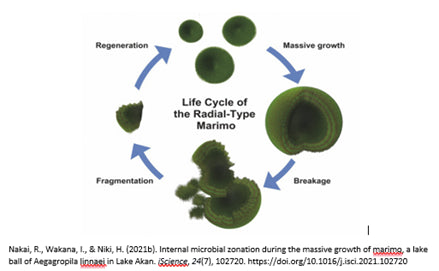
How Does Marimo Reproduce? The Answer Will Amaze You!
Here's why marimo moss ball reproduction is a hidden treasure. You might wonder, "It's just a plant, right?" But, the magic of how marimos reproduce is fascinating.
Together, let's explore the secret behind these green wonders. How do they reproduce? Get ready for a journey into nature's artistry that'll spark your curiosity and keep you engaged.
The Basics of Marimo Reproduction
Moss Amigo moss balls are more than just a pretty addition to your jar; they're a marvel of nature with a unique approach to reproduction.
Unlike other aquatic plants that rely on seeds or spores, marimo moss ball reproduction is all about simplicity and self-sufficiency. Through a process that doesn't require flowers or seeds, marimo balls ensure their kind continues to thrive and multiply.
The secret to marimo moss ball reproduction lies in two key methods: Division and Fragmentation.

Without getting too deep into the details (we'll save that for the next section), it's enough to know for now that moss balls can reproduce asexually. This means they can create new marimo moss balls by splitting them into two or allowing a piece of themselves to break off and grow independently.
Now, let's get deeper into how each method works.
Understanding Division in Marimo
The division is a fascinating aspect of marimo moss ball reproduction, allowing a single moss ball to naturally separate into two distinct entities. This process, a form of asexual reproduction, underscores the simplicity and self-sufficiency of moss balls.
Here's a closer look at how division unfolds and the optimal conditions for it to occur.
Initiation of Division
The journey begins when a moss ball reaches a specific size, and environmental conditions signal it's time to multiply. Key factors such as sufficient light, clean water, and space are crucial in signaling a moss ball to start the division process.
The Division Process
- Internal Growth: Inside the moss ball, cellular activity ramps up, preparing it for division. This internal growth is critical, ensuring both halves will be viable after separation.
- Surface Tension: Gradually, the moss ball's exterior begins to stretch and thin at its center, where the division will occur. The moss ball's internal growth dynamics influence this slow process.
- Separation: Over time, the tension at the moss ball's center becomes unsustainable, leading to a natural split. This gentle split does not harm the moss ball but produces two healthy halves.
- Final Split: Eventually, these halves part ways, each becoming an independent moss ball ready to grow independently. This marks the completion of the division process.
Maintaining Marimo Health
While understanding the division process is intriguing, it's essential to focus on maintaining the overall health and well-being of your moss ball. Providing a nurturing environment involves:
- Ensuring the water is clean and changed regularly.
- Providing moderate lighting to support photosynthesis without promoting excessive growth or division.
- Avoiding overcrowded conditions to ensure each moss ball has enough space to thrive.
Learn more: How to Clean Your Marimo Moss Ball Properly
Amazing, right?! Let's get more deeper! Continue reading...
Fragmentation: Marimo's Way of Spreading
Fragmentation plays a pivotal role in the reproduction of marimo moss balls, serving as their strategy for expansion and dispersal. This method allows moss balls to adapt and thrive in various environments, ensuring their survival and proliferation over time.
How Fragmentation Works
Fragmentation occurs when a piece of the moss ball breaks off from the main body.
This can happen naturally, often due to physical disturbance, such as:
- Water currents
- Animal interaction
- During routine handling and care by moss ball enthusiasts.
Despite its size, the detached piece contains all the necessary components to grow into a new, independent moss ball moss ball.
Contributions to Marimo Reproduction
Moss Amigos moss balls can colonize new areas through fragmentation and maintain genetic diversity within populations. This reproduction method is particularly effective in spreading moss balls across vast water areas, where they can find new homes and continue their growth.
Real-Life Scenarios
- Natural Waters: In lakes and rivers, strong currents or encounters with fauna can cause parts of moss ball to detach and be carried away to new locations.
- Jars: In home settings, gentle cleaning or accidental drops can lead to fragmentation. Enthusiasts might notice small pieces breaking off during maintenance, which can then be nurtured into full-sized moss balls.
- Environmental Changes: Fluctuations in water conditions, such as temperature and pH, might stress moss ball, leading to fragmentation as a survival strategy to spread and adapt to potentially more favorable conditions.
Also Read: Choosing the Best Water for Healthy Marimo Moss Balls
Conclusion
The journey of marimo moss ball reproduction through division and fragmentation is a testament to the resilience and wonder of these aquatic gems. Remember, caring for moss ball's lets you be part of nature's magic. Every marimo ball is like a tiny green world, ready to share its life with you.
Want to learn more or grow your moss ball family? Check out Moss Amigos. We have all you need to take care of these awesome green balls.
You can also check our Blogs for more fun facts and tips about moss balls. Join our moss ball-loving community at Moss Amigos and start your moss ball adventure today. Thanks for reading!
References:
Geiger, B. (2020, October 5). On an Alaskan glacier, little green moss balls roll in herds. Science News Explores. https://www.snexplores.org/article/alaska-glacier-little-green-moss-balls-roll-in-herds






